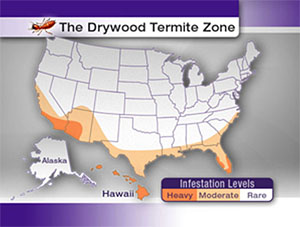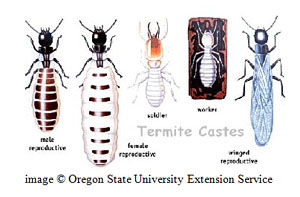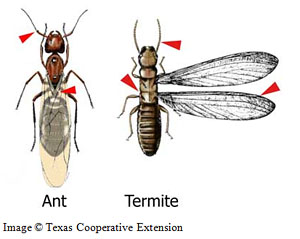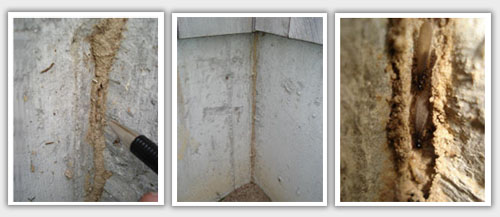





Southern California is #1 in the nation for termite activity and termite-damage costs. So, more than likely you have termites. Subterranean termites are often detected during swarming, usually in the spring, when some fly from their nests to start new colonies. Other signs are tubes made mostly of mud on the surface of walls, joists, piers, chimneys, plumbing and other fixtures. Weak or broken wood, blistered wood and soil in cracks can also be evidence of subterranean termites. Drywood termites sometimes give themselves away by creating surface blisters on wood and leaving wings or piles of waste that look like sawdust on windowsills and floors.
Not necessarily. Termites work from the inside out and are very often hard to detect. Drywood termites have no link to the outside and spend their entire lives indoors - in walls, in roofs, etc. The only way you can be sure you’re not sharing your home with termites is to have it inspected.

Subterranean termite colonies consist of three different castes--reproductives, workers and soldiers. All of the subterranean termites are generally creamy white in appearance and are translucent, looking very much in size, and shape as a grain of rice. The reproductives, or “swarmers,” have a pair of even-sized wings and are often mistaken for flying ants. The workers look similar to the “swarmers,” only they are a little smaller, don’t have wings and are lighter in color. The soldiers are also similar except for their tan-colored oversized heads and large, crushing mandibles.

Termite swarmers and ant swarmers look similar from a distance but there are some key things to look for to help you decide. Termites are poor flyers and their wings break off shortly after mating. Termites have straight antennae and an ant’s are bent. Also termites have broad thick waists where an ant has a narrow waist.

Entomologists have identified over 2000 species, 55 of which exist in the United States. But there are only two kinds, basically, that homeowners have to worry about: subterranean termites and drywood termites.
Both types are quite similar. All termites live on cellulose, which they get from wood. And all termites are social insects, much like ants. But subterranean termites usually live outside the house in underground nests. They need the moisture in the earth to survive. Since they also need cellulose, they often tunnel into nearby homes to get it. Occasionally some uncommon event, such as an AC leaking into an interior structure can allow subterranean termites to nest inside structures rather than outside in the soil. Drywood termites, on the other hand, need no contact with the earth. They live right inside the homes that they devour.
Termites have been found in buildings as early as four days after construction. Every building containing wood is a potential target of termites.
Termites are active all year in warmer climates, such as ours. They generally swarm to start a new colony in the spring or summer. As long as they have warmth, moisture and food the colony will continue to expand (…as in EAT your home).
There are many practices to termite prevention that include barrier, moisture control and anti-harboring measures for new buildings. In an existing structure, it is typically recommended that you use a chemical barrier to prevent infestation after the structure is treated. Sierra Termite offers an annual-inspection and treatment program to help keep termites from destroying your investment. Inquire for more details.
If your neighbor’s home is infested with termites, that doesn’t mean that you have them too, but the chances of infestation are certainly higher.
As shown in these pictures.

Your home may not necessarily be infested, but termites in the area means that your home is at high risk because each time the colony swarms, or grows, your home may be a prime target for the swarmers to start a new colony in or around your home.
First, you need to call your management company, or our company. If you want to spray the termites, we recommend using soapy water or glass cleaner. Using anything else is overkill and adds needless, harsh fumes. If you have swarmers, just use a vacuum to clean them up, and call us. We do ask that you leave the evidence alone or keep some in a baggy, as it helps us determine the best treatment method.
